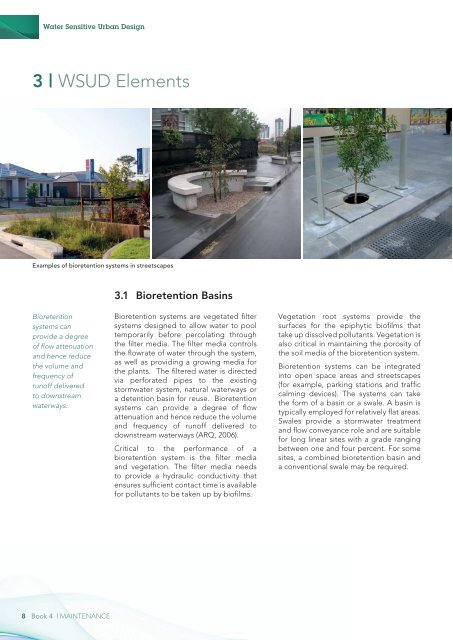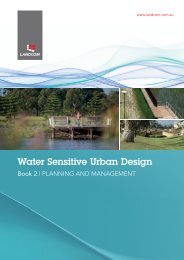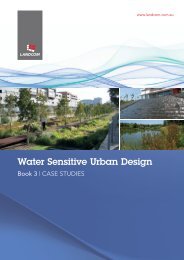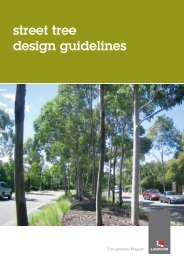Landcom Book 4 Maintenance - WSUD
Landcom Book 4 Maintenance - WSUD
Landcom Book 4 Maintenance - WSUD
You also want an ePaper? Increase the reach of your titles
YUMPU automatically turns print PDFs into web optimized ePapers that Google loves.
Water Sensitive Urban Design<br />
3 | <strong>WSUD</strong> Elements<br />
Examples of bioretention systems in streetscapes<br />
3.1 Bioretention Basins<br />
Bioretention<br />
systems can<br />
provide a degree<br />
of flow attenuation<br />
and hence reduce<br />
the volume and<br />
frequency of<br />
runoff delivered<br />
to downstream<br />
waterways.<br />
Bioretention systems are vegetated filter<br />
systems designed to allow water to pool<br />
temporarily before percolating through<br />
the filter media. The filter media controls<br />
the flowrate of water through the system,<br />
as well as providing a growing media for<br />
the plants. The filtered water is directed<br />
via perforated pipes to the existing<br />
stormwater system, natural waterways or<br />
a detention basin for reuse. Bioretention<br />
systems can provide a degree of flow<br />
attenuation and hence reduce the volume<br />
and frequency of runoff delivered to<br />
downstream waterways (ARQ, 2006).<br />
Critical to the performance of a<br />
bioretention system is the filter media<br />
and vegetation. The filter media needs<br />
to provide a hydraulic conductivity that<br />
ensures sufficient contact time is available<br />
for pollutants to be taken up by biofilms.<br />
Vegetation root systems provide the<br />
surfaces for the epiphytic biofilms that<br />
take up dissolved pollutants. Vegetation is<br />
also critical in maintaining the porosity of<br />
the soil media of the bioretention system.<br />
Bioretention systems can be integrated<br />
into open space areas and streetscapes<br />
(for example, parking stations and traffic<br />
calming devices). The systems can take<br />
the form of a basin or a swale. A basin is<br />
typically employed for relatively flat areas.<br />
Swales provide a stormwater treatment<br />
and flow conveyance role and are suitable<br />
for long linear sites with a grade ranging<br />
between one and four percent. For some<br />
sites, a combined bioretention basin and<br />
a conventional swale may be required.<br />
8 <strong>Book</strong> 4 | MAINTENANCE
















